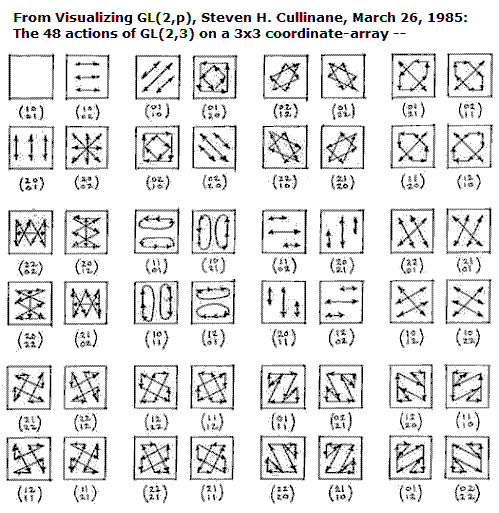-- Jonathan L. Alperin,
review of books on group theory,
Bulletin (New Series) of the American
Mathematical Society 10 (1984) 121, doi:
10.1090/S0273-0979-1984-15210-8

The same example
at Wolfram.com:
Caption from Wolfram.com:
"The two-dimensional space Z3×Z3
contains nine points: (0,0), (0,1), (0,2), (1,0), (1,1), (1,2), (2,0),
(2,1), and (2,2). The 48 invertible 2×2 matrices over Z3
form the general linear group known as GL(2, 3). They act
on Z3×Z3 by matrix multiplication modulo
3, permuting the nine points. More generally, GL(n, p)
is the set of invertible n×n matrices over the field Zp,
where p is prime. With (0, 0) shifted to the center, the matrix
actions on the nine points make symmetrical patterns."
Citation data from Wolfram.com:
"GL(2,p) and GL(3,3) Acting on Points"
from The Wolfram Demonstrations Project,
http://demonstrations.wolfram.com/GL2PAndGL33ActingOnPoints/,
Contributed by: Ed Pegg Jr"
As well as displaying Cullinane's 48 pictures of group actions from 1985, the Pegg program displays many, many more actions of small finite general linear groups over finite fields. It illustrates Cullinane's 1985 statement:
Citation data from Wolfram.com:
"GL(2,p) and GL(3,3) Acting on Points"
from The Wolfram Demonstrations Project,
http://demonstrations.wolfram.com/GL2PAndGL33ActingOnPoints/,
Contributed by: Ed Pegg Jr"
As well as displaying Cullinane's 48 pictures of group actions from 1985, the Pegg program displays many, many more actions of small finite general linear groups over finite fields. It illustrates Cullinane's 1985 statement:
"Actions of GL(2,p) on a p×p coordinate-array have the same sorts of symmetries, where p is any odd prime."Pegg's program also illustrates actions on a cubical array-- a 3×3×3 array acted on by GL(3,3). For some other actions on cubical arrays, see Cullinane's Finite Geometry of the Square and Cube.